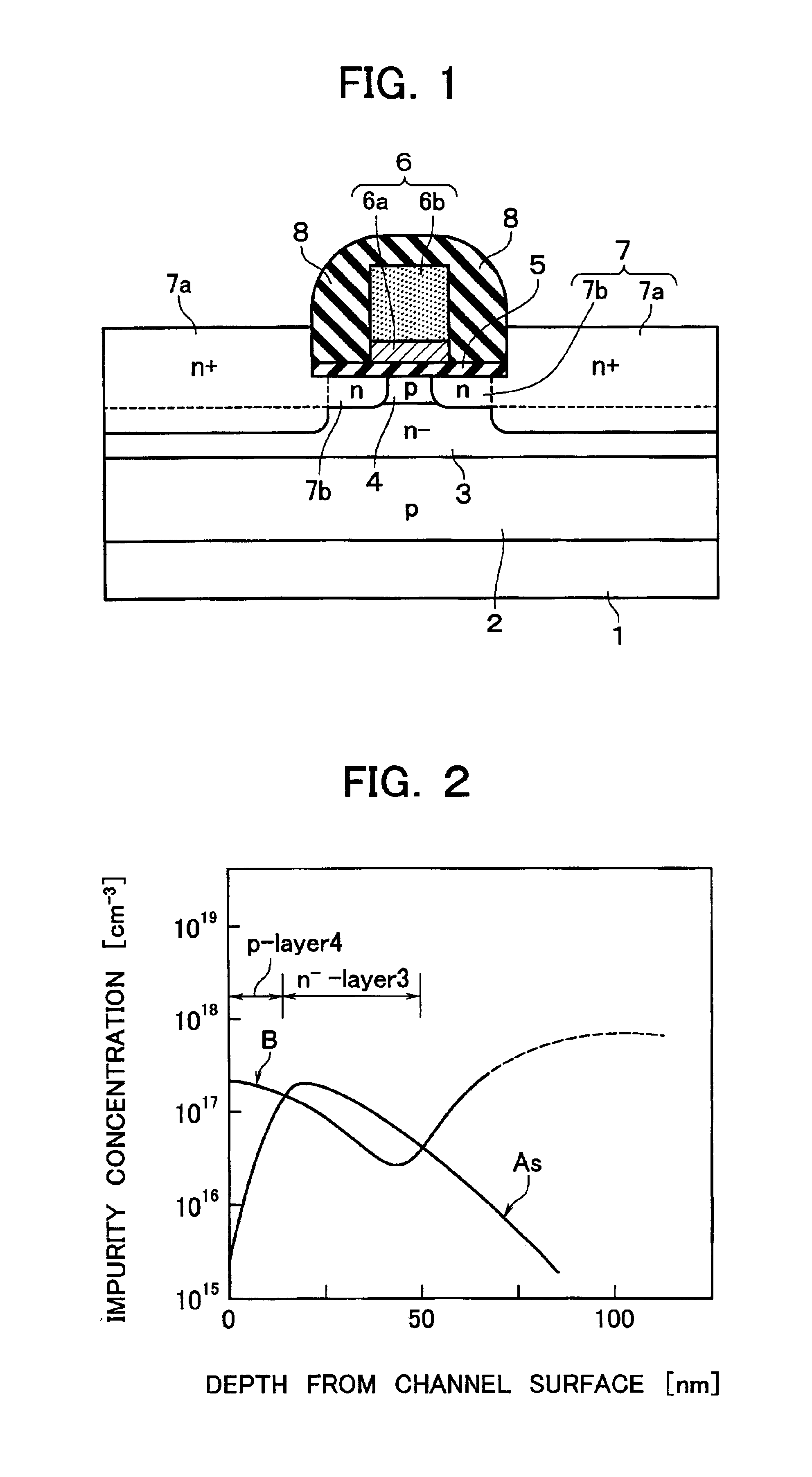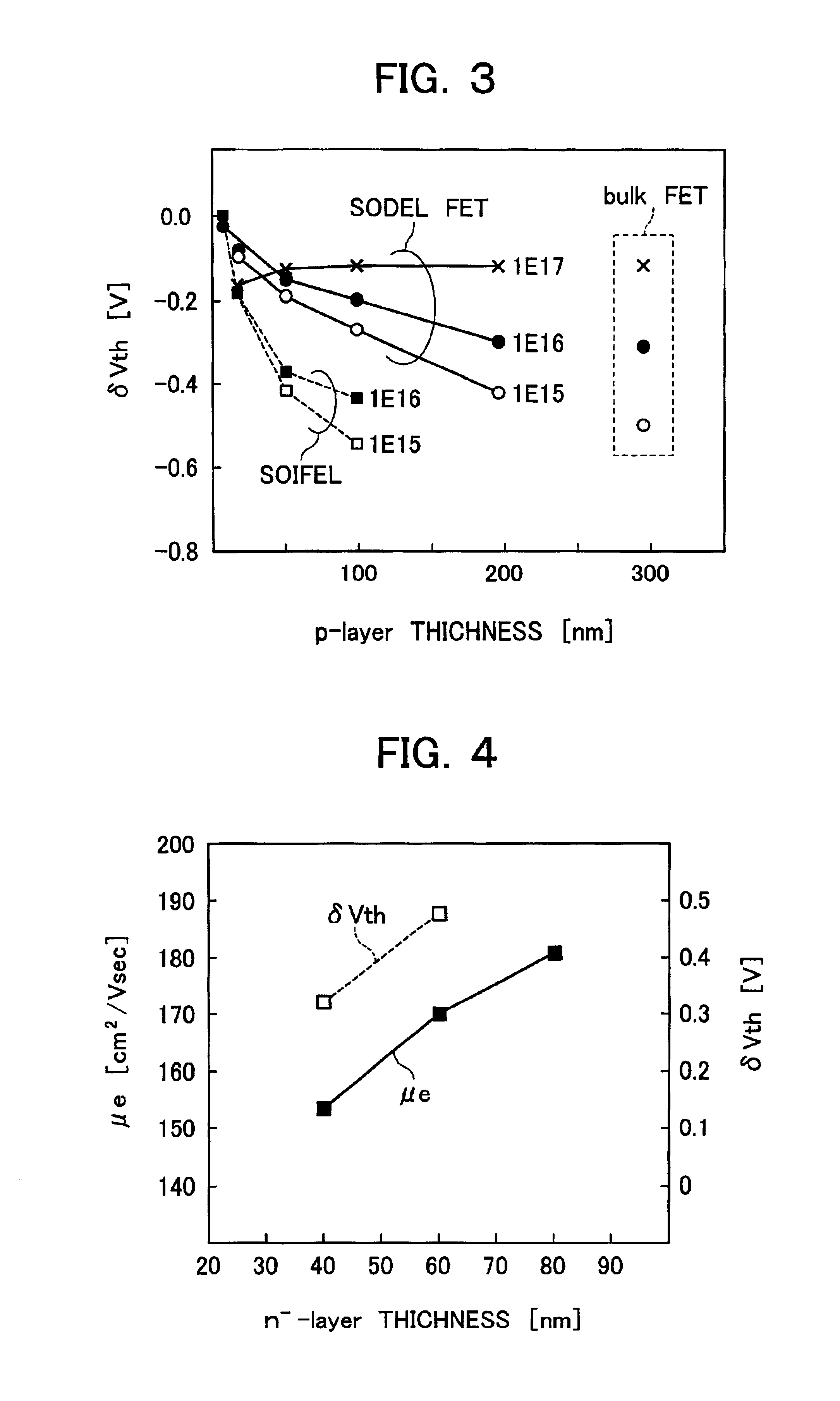Semiconductor device realizing characteristics like a SOI MOSFET
a technology of soi mosfet and semiconductor device, which is applied in the direction of semiconductor device, electrical apparatus, transistor, etc., can solve the problems of increasing performance degradation, unwanted increase of parasitic resistance value, and relatively less quality of soi substra
- Summary
- Abstract
- Description
- Claims
- Application Information
AI Technical Summary
Problems solved by technology
Method used
Image
Examples
first embodiment
[0041]Referring to FIG. 1, there is illustrated a sectional view of a structure of main part of a MISFET in accordance with a first embodiment of the invention.
[0042]A silicon substrate 1 has its top surface in which a p-type impurity doped layer 2 is formed by well ion implantation techniques. Formed on this p-type layer 2 are a lightly-doped n (n−) type impurity doped layer of low impurity concentration and further a p-type impurity doped layer 4 for use as a channel region. These layers 2-4 make up a multilayer lamination structure with p / n− / p junction. Certain portions of this p / n− / p junction multilayer structure—at least the upper p-type layer 4 and its underlying n−-type layer 3—are fabricated by epitaxial growth process and ion implantation process in combination, as will be described in detail later in the description.
[0043]As shown in FIG. 1, a gate electrode 6 is formed over the p-type layer 4 for use as the channel region, with a gate dielectric film 5 being interposed th...
second embodiment
[0073]In the first embodiment above, even with optimization of the impurity concentration and thickness values of the p / n− / p junction multilayer structure, punch-through phenomena will possibly become hardly negligible between the source and drain in highly integrated semiconductor devices of the generation with 50-nm gate lengths or later generations.
[0074]See FIG. 14. This diagram depicts a sectional view of an SODELFET structure capable of preventing any punch-through with increased reliability in accordance with a second embodiment of the invention, wherein the depiction here is shown in a way corresponding to FIG. 1. This embodiment is similar to that of FIG. 1 except that p-type layers 9 are additionally provided as “halo” regions. These layers are buried in the n−-type layer 3 at locations immediately beneath the source / drain extension regions 7b, respectively. As in the first embodiment, appropriate value setting of the impurity concentration and thickness of p-type layer 4 ...
third embodiment
[0078]Turning to FIG. 15, there is shown in a manner corresponding to FIG. 1 a sectional view of an SODELFET also embodying the invention, which employs selective ion implantation to selectively fabricate the intended p / n− / p junction multilayer structure in a specified region immediately beneath a gate electrode. Unlike the embodiment of FIG. 1, arsenic (As) ion implantation is selectively done only at a channel body forming portion of an undoped or “nondoped” epitaxially grown silicon layer 10, thereby forming an n−-type layer 3. Thus the resulting extension regions 7b of source / drain diffusion layers 7 are such that the bottom surface of each is in contact with its underlying n−-type layer 3 while a respective n+-type low-resistivity region 7a has its bottom face residing within the nondoped silicon layer 10.
[0079]As per the p-type layer 4 for use as a transistor channel region also, this is manufacturable similarly by selective ion implantation of boron (B).
[0080]Forming the n−-t...
PUM
 Login to View More
Login to View More Abstract
Description
Claims
Application Information
 Login to View More
Login to View More - R&D
- Intellectual Property
- Life Sciences
- Materials
- Tech Scout
- Unparalleled Data Quality
- Higher Quality Content
- 60% Fewer Hallucinations
Browse by: Latest US Patents, China's latest patents, Technical Efficacy Thesaurus, Application Domain, Technology Topic, Popular Technical Reports.
© 2025 PatSnap. All rights reserved.Legal|Privacy policy|Modern Slavery Act Transparency Statement|Sitemap|About US| Contact US: help@patsnap.com



